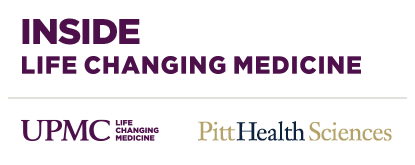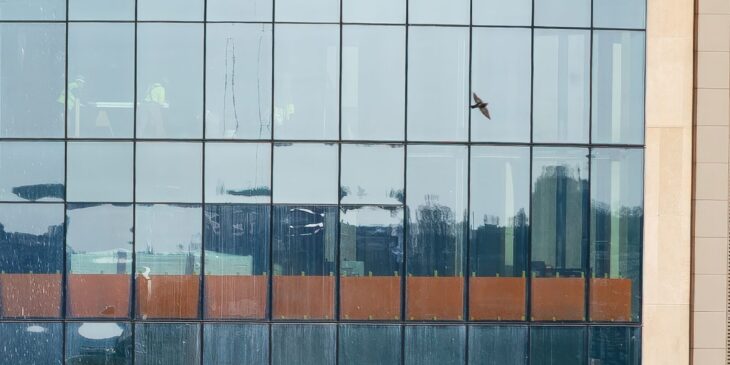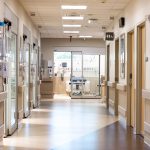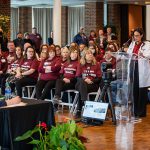Each year, millions of birds fly over Pittsburgh during migration cycles. While the built environment often poses risks for our feathered friends, the design of the new UPMC Presbyterian bed tower will minimize the risk of bird strikes through bird-safe glass, the result of a partnership that’s just one positive impact of the transformational construction project.
In collaboration with Carnegie Museum of Natural History and architecture firm HGA, this glass has been specially designed and manufactured to reduce deadly window strikes of migratory birds passing through the city’s Oakland neighborhood.
“While a lot of buildings are eventually modified to address bird strikes, the UPMC Presbyterian tower is one of the first construction projects in the city to proactively plan for it,” said Michael Schesler, director of Construction, UPMC.
The Science Behind the Strikes
Several factors determine how many birds will pass through the city during annual migration cycles, including bright lights, Pittsburgh’s proximity to forests, and its vast river system.
Worldwide, estimates put window strike fatalities for birds north of one billion every year. This includes both immediate deaths and those birds that eventually will succumb to injuries sustained in a strike.
Birds are most susceptible to window strikes as they forage for insects, going from bush to bush and tree to tree. The main areas of concern on the new tower were the three stories above the lobby and around the rooftop raised garden where planted trees and greenery entice birds to land.
Jon Rice, Urban Bird Conservation Coordinator at Carnegie Museum of Natural History, worked closely with UPMC construction leaders and architects at HGA as they looked at the potential impacts the building could have on local landscape and bird life. While the glass façade will give the building its striking appearance, it also poses a special risk for birds.

Making the Right Kind of Impact
The installation of bird-safe glass is just one of several sustainable efforts involved in the construction of the UPMC Presbyterian bed tower and is an example of the teamwork of several different groups coming together to solve one collective problem.
“We want to be good stewards with the city and with the community,” said John Krolicki, vice president, Facilities and Support Services, UPMC Presbyterian Shadyside, chief administrative sustainability officer, and vice president, Public Safety Operations, UPMC. “A lot of thought was put into this that goes above and beyond just building a building.”
Schesler agreed, noting that the project is characterized by innovations from workforce development and prefab construction to public art and community connections. “We’ve pushed the envelope on a lot of different fronts for this project, and the bird-safe glass is just one aspect of our overall effort.”
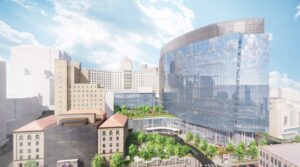
With a literal towering example of what is possible when ideas are investigated and implemented, thoughtful construction like this could one day be the new normal.
“We’re addressing sustainability through lots of different angles and integrating as many as many of those aspects as we can, said Alex Terzich, associate vice president and senior project architect at HGA. “The bird-safe glass is just one of the issues that is meaningful and is going to impact the success of the building. It’s about the health and safety of the birds, but also about the mental well-being of patients and visitors to the building.”
A Big Win for the Birds
As he drove home from work one day and went by the site in late 2024, Rice was amazed at the progress of the building and saw what was once a suggestion coming to fruition. “It means a lot,” he said. “I’ve served as the museum’s Urban Bird Conservation Coordinator since my hiring in 2016, focusing on bird safety throughout my tenure. We’ve celebrated small victories along the way, and while our primary collaborations have been with environmental non-profit organizations, Carnegie Museum of Natural History is thrilled to partner with UPMC, one of Pittsburgh’s largest healthcare providers, to make a significant impact on bird safety.”
The UPMC Presbyterian project is the largest construction project ever undertaken by UPMC. “UPMC is always proud to work to make our community a better place. This is going to be a destination of health and wellness and where people come to heal,” Schesler said. “It is full of firsts for UPMC, and the collaboration with the Carnegie Museum of Natural History and HGA in installing bird-safe glass is just one example of our continued commitment to make this project more than just a building. UPMC is a worldwide leader in health care known for our innovation, and we are proud to mirror that expertise as we build our facilities of the future.”


